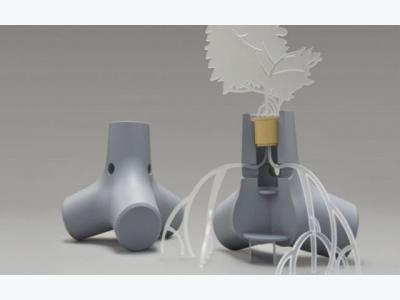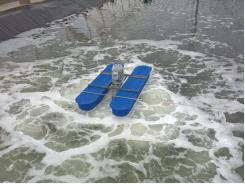TetraPOT

TetraPOT is a sea defence system.

It’s an ecosystem. A home for other livings.

The roots form a natural sea defence.

Manufacturing process consideration

The design protects a natural habitat.

Put the real plants inside the model.

Ideas sketching.

Project design process.

Rough sketching and some 3D printing models.

Model components are made of ABS material.
What It Does
TetraPOT is a sea defence system. Distribute it along coastlines will interlock to create a long-lasting sea defence of growing trees and roots that help keep the blocks in place. The roots will intertwine and gradually become a natural sea defence.
The Inspiration
Current artificial sea defence structures tend to be dislodged over time by the force of the ocean constantly crashing against them. They have also been criticized for destroying the natural scenery along coastlines. As for natural sea defence, more than 35% of the world’s mangroves are already gone because of the greenhouse effect. We not only identified some challenges but also found some opportunities that we’re going to focus on, e.g. Under mutual benefit theme, we will create symbiosis between artificial sea defence and natural sea defence. As our slogan goes, “It is not only a defence, but also an ecosystem. A home for other livings.”
How It Works
INSTRUCTION
1. Arrange TetraPOTs with mangrove seeds held by organic layers along the coastline in an interlocking way.
2. When the sea level goes up, certain amount of water will be collected in the recess part inside TetraPOT.
3. As tree grows, the organic layers start to be decomposed, with roots reaching down to the bottom for water.
4. Tree roots start to come out from designated channels and surround TetraPOTs over a period of time. The roots will then grab the land, forming a natural sea defence.
MANUFACTURING
1. Assemble and bolt 3 pieces of metal cases and place core pillar on the top of edge of metal case.
2. Insert 3 sub-pillars separately to hole of metal case outside and attach to the core pillar inside.
3. Pour concrete from the gap of the cover on the top and wait until concrete dry and pull out all the pillars.
4. Disassemble and unbolt 3 metal cases. Place the biodegradable pot to complete the assemble of TetraPOT unit.
Stages of Development
DESIGN PROFILE
1. Dimensions: 1.5m*1.5m*1.5m (L*W*H)
2. Weight of the project: 1 ton
3. Materials Used: Concrete, Decomposable Material, Soils, and Copper
MANUFACTURING PROCESS CONSIDERATION
Since TetraPOT is a sustainable and greener sea defence design, the improvement on the manufacturing side is foreseeable as well.
1. Less Material
Use less concrete, because there are certain hollow spaces for plants.
2. Less Manufacturing Steps and Time
Save more time to produce, because TetraPOT need less material than traditional method.
3. Zero Maintenance
No need to artificially maintain sea defence, because plants will eventually grab TetraPOTs and hence sustain stronger sea defences.
In terms of product distribution, TetraPOT is currently available on the seashore, because sea defences, e.g. TetraPOT, are normally manufactured at the coastal line where they need be placed. Since the team is based in Shanghai, at the moment we will try to cooperate with the Shanghai municipal government and we want to test TetraPOT on Chong Ming Island. The first date placed into distribution or completed date is between 2016 and Feb 6, 2017.
Novelty
This is the topic that people/designers would seldom touch on from the sustainability perspective. What makes the TetraPOT innovative is that we create symbiosis between artificial sea defence and natural sea defence. As our slogan goes, “It is not only a defence, but also an ecosystem. A home for other livings.”
Because we put more emphasis on mutual benefit/value, it makes sense for us to combine “Tetrapod” with “Mangrove” which means combining “Artificial Sea Defence (Armor. Cold. Unwieldy)” with “Natural Sea Defence (Protection. Friendly. Sustainable)”. In short, the perception shift will be from building more “Concrete Armor Unit” to having a “Sustainable and Greener Coastal Line”. As a result, our project name is turned from “TetraPOD” to “TetraPOT” (Pot means a container).
Future Plans
SOCIETY & CULTURE
We hope it can raise people’s awareness of environmental protection issue and want to develop the sustainable model so that the project can maximize its social impact on different levels and become a culture.
ENVIRONMENT
TetraPOT not only maintains its functionality but also enhance aesthetic in terms of protecting Mother Nature. The ultimate goal is to reach a balance between nature and artificial stuff.
ECONOMY
Human will pursuit “Green Economy” in the end. The project cost including designing, manufacturing and materials for producing each sea defence are decreasing compared with the traditional design.
Awards
2016 ─ IDEA, Top Winner ─ Environments
2016 ─ red dot Design Award, Winner ─ Habitat
2016 ─ Spark Award, Winner ─ Concept, Professional
2016 ─ A' Design Award & Competition, Silver ─ Sustainable Products and Green Design
2016 ─ International Design Awards, Gold ─ Design for Society, Sustainable Products
Related news
Tools

Phối trộn thức ăn chăn nuôi

Pha dung dịch thủy canh

Định mức cho tôm ăn

Phối trộn phân bón NPK

Xác định tỷ lệ tôm sống

Chuyển đổi đơn vị phân bón

Xác định công suất sục khí

Chuyển đổi đơn vị tôm

Tính diện tích nhà kính

Tính thể tích ao




 A new diffused-aeration concept for aquaculture
A new diffused-aeration concept for aquaculture  Aeration - A Wastewater Treatment Process
Aeration - A Wastewater Treatment Process